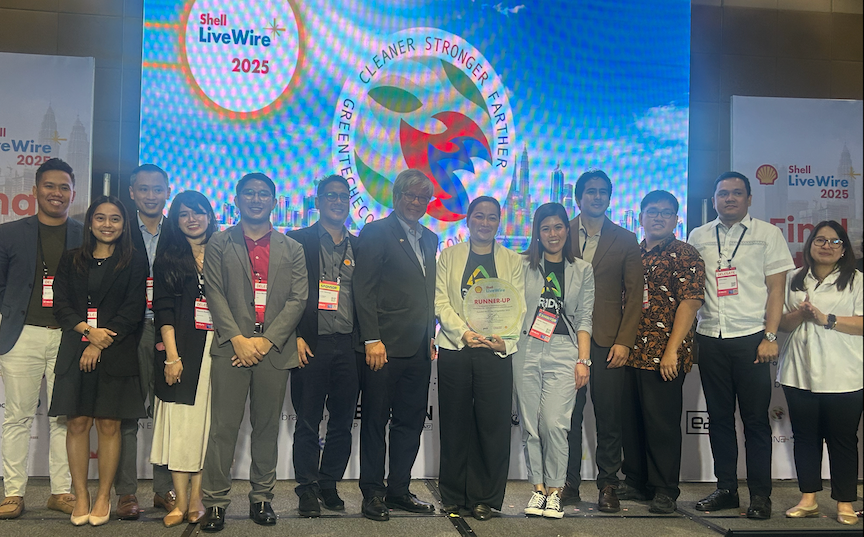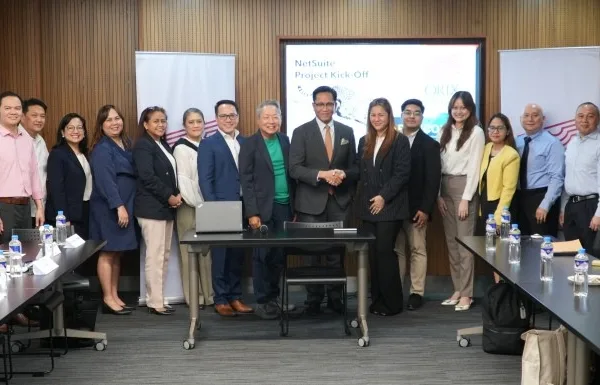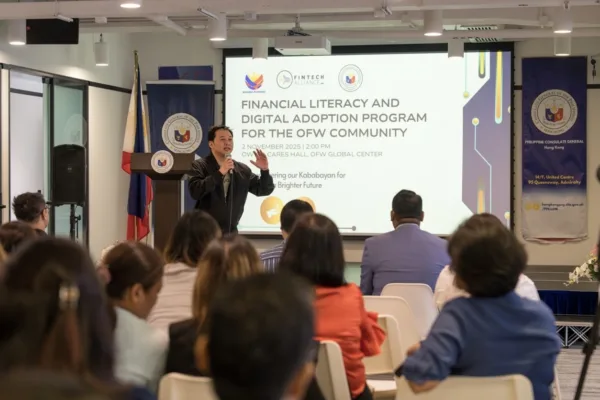For Jennifer Joy Subang, Chief Operating Officer of SF Group of Companies Inc. and also co-founder and Chief of Operations (COO) of AgriDOM Solutions Corp., the biggest challenge facing Philippine agriculture is not the fear of artificial intelligence or robots replacing farmers.
It’s the fact that there are fewer and fewer farmers left.

AgriDOM executives, led by Jennifer Joy Subang (8th from left), join Shell Pilipinas Corporation officials, led by Sebastian Quiñones (7th from left), during the awarding ceremony of Shell LiveWire 2025.
“People think drones will take away jobs. But the reality is, there aren’t enough people to farm anymore,” Subang said in an exclusive interview with FintechNewsPH.com on the sidelines of the Shell Livewire 2025 event, where AgriDOM was one of the finalists. “What makes us happy is not just profit — it’s helping smallholding farmers who need this technology the most.”
From rice exporter to rice importer

The Philippines was once a rice exporter. Today, however, it has the dubious distinction of being the world’s largest importer of rice, sourcing most of its supply from Vietnam and Thailand.
“These same countries,” Subang pointed out, “have been aggressively adopting drone technology in agriculture for more than a decade.”
She noted that Thailand alone imports around 5,000 agricultural drones every year. By contrast, the Philippines brings in just 200 to 300 units annually. “That’s the gap,” she said.
For Subang, drones represent more than futuristic gadgets. They are practical tools that could help the Philippines regain food security. Rice farming alone covers 2.5 million hectares and employs about the same number of farmers. Yet many of the critical processes between planting and harvesting — such as seeding, spraying, and fertilizing — remain largely manual, costly and inefficient.
AgriDOM drones: Faster, cheaper, smarter

AgriDOM is one of only two licensed and legally operating drone service providers in the Philippines — and currently the largest. The company plays a key role in the government’s “Drone for Rice” program, which deploys drones to help Filipino farmers with tasks like spraying and broadcasting fertilizer.
“When farmers see the drone in action, they’re amazed,” Subang explained. “In just five minutes, one hectare is finished. Costs are reduced because there’s no excessive spraying, and precision ensures healthier crops.”
The impact has been immediate. In the Cordillera Administrative Region (CAR), AgriDOM began with just 100 adopters. That number quickly grew to 500 farmers, and by the next cropping season this September, more than 1,000 farmers had signed up.
Nationwide, AgriDOM now works with around 6,000 farmers across 14 of the country’s 18 regions.
“The demand is clear. The challenge now is scaling,” Subang said.
The scaling challenge: More pilots, not drones

Ironically, the bottleneck isn’t drone supply. “We can get as many drones as needed. The problem is pilots,” Subang admitted. Training drone operators — what she calls ‘drone-preneurs’ — is now a priority.
Other countries have surged ahead. Malaysia and Thailand, for example, already have a decade of experience in drone farming. The Philippines, meanwhile, is still catching up.
“The entry barriers here are very high,” Subang explained. “A single agricultural drone costs millions. Add regulatory approvals, licensing hearings, inspections, and certifications — it’s not easy for startups. We weathered all that, but for others it’s daunting.”
To address this, AgriDOM pioneered a franchising model unique not just in the Philippines but globally. This allows local entrepreneurs and cooperatives to operate drone services without shouldering the full cost of ownership.
“This is something even other countries don’t have. We’ve already been approached by partners in Africa to replicate the model there. But I said, let’s finish building it here (in the Philippines) first.”
Toward a sustainable future

Beyond efficiency, Subang stressed that drone farming also promotes safer and more sustainable practices.
In Mindanao’s banana plantations, for instance, aerial spraying is still done using small planes — a dangerous practice that has led to accidents. Drones, by contrast, eliminate the need for manned flights, reducing risk.
Powered primarily by batteries, drones also present a cleaner alternative to fuel-intensive machinery. While AgriDOM still relies on fuel for some operations, Subang said the shift to electric systems is underway.
Check out this video to learn more about how AgriDOM’s drone farming technology is making a real difference in farmers’ lives:
Since its founding, AgriDOM has already served over 2,000 farmers in Visayas and Mindanao, covering more than 300,000 hectares of rice, corn, banana, and coffee farms. By reducing chemical exposure and lowering input costs, the model not only boosts yields but also makes farming safer and more sustainable.
Looking ahead, Subang sees drone technology not as a threat, but as a lifeline for Philippine agriculture.
“The question is not whether drones will replace farmers,” she said. “It’s whether we can bring technology fast enough to help the farmers who remain — and to ensure we can feed ourselves as a nation.”








